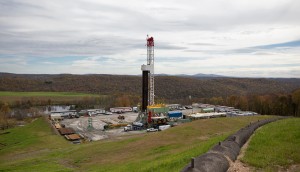Pennsylvania case studies mirror EPA’s national fracking report
-
Jon Hurdle

Lindsay Lazarski/WHYY
The EPA’s case studies included Susquehanna County where this Cabot gas rig was working
A federal investigation into links between fracking and drinking water contamination in Bradford and Susquehanna Counties found some private water wells had been damaged by methane and ethane migration caused by nearby fracking. But the report found no evidence that homeowners’ private water wells and springs had been affected by frack fluids or waste water.
In Washington County, the same probe found ground water near a gas industry waste water impoundment contained chlorides that exceeded the federal health limit but that methane found in about a quarter of wells tested was naturally occurring.
The two case studies were among five cited by the U.S. Environmental Protection Agency in its long-awaited national investigation into the potential impacts by fracking for oil and gas on drinking water resources.
The Pennsylvania studies were broadly consistent with the national report, released on June 4, concluding that across the U.S. there was no evidence of a widespread impact to drinking water although there were “specific instances” where fracking-related mechanisms had affected water sources including the contamination of drinking water wells.
The Pennsylvania Department of Environmental Protection reports 256 specific incidents of private water supply impacts resulting from both conventional and unconventional (shale gas) drilling. Those incidents include water wells that have run dry as well as contamination.
The Pennsylvania cases, like three other “retrospective” studies in Texas, Colorado and North Dakota, were chosen because of factors including reported evidence of impaired water quality, proximity of population to gas development, and “knowledge gaps” that could be filled by a case study, the EPA said.
In the northeastern Pennsylvania counties, two of the most intensively drilled in Pennsylvania’s Marcellus Shale, the study found “no evidence” of frack fluids, flowback water or produced water in residents’ water sources, and ruled out fracking as the source of organic and inorganic material found in ground water.
After examining 36 domestic wells, two springs, and two surface water locations, mostly in Bradford County, between October 2011 and May 2013, the study found that stray gas associated with fracking had affected wells in one or more of the households studied.
It said the stray gas appeared to be coming from geological formations above the Marcellus Shale.

Susan Phillips / StateImpact Pennsylvania
Empty water jugs used to haul clean water hang from a house in Washington County. Residents suspected nearby gas drilling as the culprit. The DEP investigation concluded drilling was not to blame.
A few wells contained chemicals associated with fracking such as chloride, sodium, and barium at levels higher than occurring elsewhere in the study area, but those levels were attributed to natural conditions, the study said.
“The results of an analysis of a broad suit of organic and inorganic constituents/compounds potentially linked to hydraulic fracturing indicated no evidence of impacts on groundwater other than stray gas in the form of methane and ethane,” the EPA said in the 671-page northeast Pennsylvania report.
In Washington County, southwest Pennsylvania, EPA investigators took samples from 16 wells, three springs, and three surface water sources between July 2011 and May 2013. They found an elevated level of chlorides that likely originated at the Yeager impoundment in Amwell Township, where some local residents have sued the operator, Range Resources, claiming the site leaked toxic material, damaging their health.
“The water quality trends with time suggest that the chloride anomaly is linked to sources associated with the impoundment site,” the 482-page report said.
Detection of volatile and semi-volatile organic compounds in Washington County were infrequent; were below federal maximum contaminant limits (MCLs), and did not correlate to other indicators of hydraulic fracturing fluids such as elevated chlorides or the presence of glycol ethers.
Although the researchers found little evidence that fracking-related materials were impacting drinking water in either of the two Pennsylvania areas studied, the project highlighted the ways in which water sources might be affected by the industry, the EPA said.
It also rejected accusations by some critics that its study contained little original research.
“The case studies provide valuable insights into the vulnerabilities and potential pathways for impacts to drinking water resources from hydraulic fracturing activities,” the agency said in a statement to StateImpact.
“Our experience in conducting the case studies highlights the value of site-specific background data, including the chemicals used on site, and local geological information,” the EPA said. “Other field work included sampling of rivers to better understand the presence, fate and transport of materials associated with hydraulic fracturing.”
Other new work included modeling and scenario evaluations, and new analysis of existing data, the agency said. It also said it will “shortly” provide spreadsheet data on possible water contaminants used in fracking, including their toxicity, for use in future risk assessments.
Asked to respond to allegations that it avoided broadly criticizing shale gas because it did not want to conflict with Obama administration energy policy, the EPA said its report was a “state of the science” study, and not a policy document.
“EPA set out to conduct a national study to determine whether there was potential for impacts to drinking water resources from hydraulic fracturing for oil and gas, and if so, to identify the drivers for those impacts,” it said. “EPA did just that: this state-of-the-science draft assessment identifies specific instances where hydraulic fracturing activities have impacted drinking water resources, and most importantly, highlights vulnerabilities identifies key vulnerabilities to drinking water resources.”
Dr. Trevor Penning, director of the Center for Excellence in Environmental Toxicology at the University of Pennsylvania, defended the EPA from accusations that it did little new field work.
“I think they’ve done a good job in terms of what’s available, and I think they’ve done a good job on the five retrospective studies,” he said.
By its own admission, the agency was hampered by knowledge gaps such as a lack of baseline data or companies’ refusal to disclose proprietary chemicals, Penning said.
But he argued that the thoroughness of its research supports the contention that fracking does not have systemic impacts on drinking water sources.
“The bottom line is that although in some instances they did find contaminants in private drinking-well water in exceedance of the maximum contaminant level, they could not with certainty attribute most of those contaminants to hydraulic fracturing,” Penning said.
















